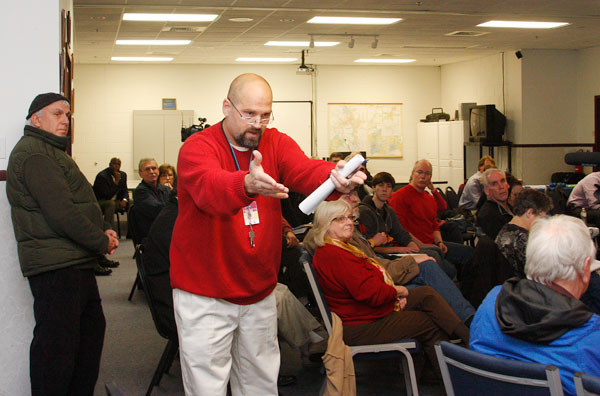
Emotions ran high at a March 10 press conference and community meeting at the Skyland Fire Department concerning the former CTS of Asheville plant. As uniformed police officers wearing bulletproof vests kept watch, U.S. Environmental Protection Agency officials announced that the plant and adjacent Mills Gap Road property have been proposed for addition to the National Priorities List of hazardous-waste sites. Addition to the list would rank the property among the most contaminated sites in the nation, qualifying it for cleanup under the Superfund program.
Despite the evident tension, the discourse remained civil, though facilitator Dan Dozier’s assertion that “The federal government is pretty good at being transparent” prompted mocking laughter from the audience. Neighboring residents have long been frustrated by the extremely slow state and federal response to the documented problems in the area.
The latest announcement is no guarantee of federal action to clean up the site, however. An EPA press release last September announcing that the agency was considering proposing the action it has now taken cautioned, “Consideration to propose the site to the NPL does not guarantee that the site will be proposed or that the site will be listed on the final NPL.” Nonetheless, officials addressing the crowd explained the NPL investigation-and-remediation process as if it were already under way. Yet Remedial Project Manager Samantha Urquhart-Foster told the assembled community members, congressional staffers and reporters, “We weren’t sure we were going to be here a week ago.”
EPA officials said the decision was based on ground-water studies conducted over the past three years, which have shown elevated — and, in some cases, extremely high — levels of chemicals such as trichloroethylene, a suspected human carcinogen. Although testing by both the EPA and the state Department of Environment and Natural Resources dates back at least to the early 1990s, one resident’s well wasn’t tested until 2009. TCE was used to clean and/or degrease metal objects prior to electroplating at the plant; ingesting TCE or inhaling the vapors can cause health problems ranging from headaches to severe liver damage, according to the U.S. Agency for Toxic Substances & Disease Registry.
Some residents — particularly three families living within a mile of the Mills Gap Road site — drank from contaminated wells for a decade or more. Many have reported numerous health problems, including cancer and immune disorders. And a group of residents recently filed a lawsuit against CTS.
 The Elkhart, Ind.-based CTS Corp. operated the plant from 1959 to 1986, then sold most of the property to Mills Gap Road Associates the following year. In 1997, the limited-liability company sold about 45 acres to the Biltmore Group for development as Southside Village, a residential community. The remaining roughly 9-acre parcel, vacant and fenced off, is assumed to harbor “a mother lode” of contamination in its soils, noted resident Tate MacQueen of the Citizens Monitoring Council, an advocacy group. MacQueen has highlighted evidence of an illegal dumping system on the property, including a presumed effluent-drainage system and partially buried storage barrels. Video shown at the group’s meetings has featured former CTS employees describing procedures for dumping hazardous waste into this system while the plant was still in operation; state records tracking hazardous chemicals used at the facility show discrepancies between the quantities of toxic chemicals delivered to the plant and those trucked away for proper disposal.
The Elkhart, Ind.-based CTS Corp. operated the plant from 1959 to 1986, then sold most of the property to Mills Gap Road Associates the following year. In 1997, the limited-liability company sold about 45 acres to the Biltmore Group for development as Southside Village, a residential community. The remaining roughly 9-acre parcel, vacant and fenced off, is assumed to harbor “a mother lode” of contamination in its soils, noted resident Tate MacQueen of the Citizens Monitoring Council, an advocacy group. MacQueen has highlighted evidence of an illegal dumping system on the property, including a presumed effluent-drainage system and partially buried storage barrels. Video shown at the group’s meetings has featured former CTS employees describing procedures for dumping hazardous waste into this system while the plant was still in operation; state records tracking hazardous chemicals used at the facility show discrepancies between the quantities of toxic chemicals delivered to the plant and those trucked away for proper disposal.
The EPA recently stepped up its sampling of private wells within a one-mile radius of the site. That effort, together with an analysis of wells now deemed at risk of becoming contaminated, pushed the site’s hazardous-ranking system score over the minimum threshold of 28.5, enabling it to qualify for consideration as a Superfund site.
 Resident and activist Barry Durand drew applause when he requested that a 2002 emergency-response order issued by the EPA be allowed to proceed alongside the Superfund process, because of the threat of continued migration of contaminants off-site. “It’s comparable to a fuel tanker that’s been overturned,” Durand argued. “It needs to be contained and addressed right away. It’s a time-critical situation.”
Resident and activist Barry Durand drew applause when he requested that a 2002 emergency-response order issued by the EPA be allowed to proceed alongside the Superfund process, because of the threat of continued migration of contaminants off-site. “It’s comparable to a fuel tanker that’s been overturned,” Durand argued. “It needs to be contained and addressed right away. It’s a time-critical situation.”
For more information on this and other CTS issues, click here.
Photos by Jonathan Welch





Before you comment
The comments section is here to provide a platform for civil dialogue on the issues we face together as a local community. Xpress is committed to offering this platform for all voices, but when the tone of the discussion gets nasty or strays off topic, we believe many people choose not to participate. Xpress editors are determined to moderate comments to ensure a constructive interchange is maintained. All comments judged not to be in keeping with the spirit of civil discourse will be removed and repeat violators will be banned. See here for our terms of service. Thank you for being part of this effort to promote respectful discussion.